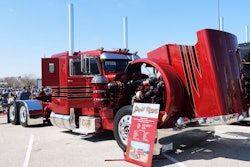FEDERAL TRUCK PARKING STUDY GENERATES MIXED RESPONSE
The Federal Highway Administration released a somewhat upbeat report on truck parking in July, saying there are plenty of spaces across the nation and that 12 states face an overall shortage.
The report says parking areas for trucks and buses along major roads and highways are “more than adequate across the nation when both public and commercial parking facilities are factored in.” Still, the study concedes, “It is not clear that an adequate number of parking spaces exists in all states or along certain high truck volume corridors.”
The study finds that 12 states – California, Colorado, Connecticut, Delaware, Idaho, Illinois, Indiana, Kentucky, Massachusetts, Ohio, Texas and Washington – have an overall shortage of public and private spaces; 35 states have shortages in public rest areas. Only eight states have a shortage of private parking spaces. The report says public rest areas along highways are not intended to accommodate truck-parking demand.
“We are gratified that this federal study has discredited the myth that this country suffers from a nationwide parking shortage,” says Scot Imus, vice president of government affairs for NATSO, the trade association representing truck stop and travel plaza operators. “This comprehensive report validates our position that shortages exist only in isolated parts of the country where the private sector has been prevented from meeting the needs of its customers.”
Not everyone reads the report as positively as NATSO. “The study confirms what America’s professional truck drivers tell us every night after having spent hours searching for a safe, secure parking space in which to get their required rest: that along major trucking corridors in the United States, the demand for truck parking spaces far outstrips the supply,” says William Canary, president of the American Trucking Associations.
ATA is supporting the study’s recommendations for states to expand or improve public rest areas; to expand or improve commercial truck stops and travel plazas; to educate or inform drivers about available spaces; and to change parking enforcement rules.
NATSO disagrees with the recommendation that commercialization of state rest areas be explored. “Allowing state-supported commercial establishments on the right-of-way would destroy the competitive interchange environment where over 90 percent of truck parking is found,” Imus says.
In 1996, ATA completed a study for FHWA that concluded public rest areas were short some 28,400 spaces. That same study surveyed truck stop owners; 84 percent of the respondents said that their facilities were full or overflowing at night.
The study is available online at safety.fhwa.dot.gov/repctoc.htm.
– Sean Kelley
DRIVER HISTORY, FATIGUE TOP SAFETY ISSUES
The best ways to reduce truck-related fatalities are to identify problem drivers before they get involved in fatal accidents and to do more to eliminate driver fatigue, concluded safety officials meeting in Washington, D.C.
The scientists and safety experts assembled by the Federal Motor Carrier Safety Administration in June focused especially on driver history, which makes up the largest single contributing factor in fatal truck crashes, according to FMCSA statistics. More than 18 percent of truckers in fatal accidents had at least one accident in three years prior to the accident. Drivers with moving violations were also frequently involved in deadly wrecks.
“Twenty percent of drivers are involved in 80 percent of accidents,” said Ron Knipling, of Virginia Tech’s Transportation Institute.
Attendees said driver fatigue is an underreported cause of many accidents. Driver fatigue is largely a management problem, says Richard Grace, of Carnegie Mellon University. There is a strong connection between carrier practices, especially scheduling, and fatigue, he said.
In addition to driver behavior issues, attendees also placed priority on: poor managerial oversight of drivers by carriers, driver turnover, inadequate hiring practices and infrequent safety training. Unattainable shipment schedules, pay issues and the demands of shippers and receivers were ranked as lower priorities.
Conclusions from the meeting will be considered by FMCSA as it develops its Safety Technologies for 2010 Research and Technology Program, which is charged with helping reduce large truck crash fatalities and injuries 50 percent by 2010.
– Tim Barton
ROADCHECK FINDS FEWER PROBLEM TRUCKS
A 72-hour intensive inspection of trucks held nationwide in early June found fewer trucks with critical safety defects than a year ago, the Commercial Vehicle Safety Alliance says.
During Roadcheck 2002’s more than 49,000 inspections at locations throughout Canada, Mexico and the United States, inspectors found that 6 percent more vehicles were free of critical safety defects than in 2001. Those trucks received a CVSA decal, certifying them as inspected for up to 90 days.
“We are pleased that the results indicate a trend in the positive direction,” says Stephen Campbell, CVSA executive director.
For all inspections, 78 percent of the vehicles met safety standards for mechanical fitness, with 22 percent placed out of service because of various defects and violations. Since 2000, the vehicle out-of-service rate has dropped from 26.2 to 22.1 percent.
Brake problems once again were the most frequent cause of vehicles being put out of service, accounting for 53 percent of violations.
As in 2000 and 2001, 94 percent of the drivers met the safety fitness standards, with 6 percent placed out of service. Of drivers placed out of service, 58 percent violated hours-of-service regulations. One percent were taken off the road due to drug or alcohol violations.
WHAT’S GOING TO HAPPEN WHEN TOUGH NEW STANDARDS FOR EMISSIONS TAKE EFFECT IN TWO MONTHS?
Read eTrucker.com’s Monthly Focus during August for test drives of the four new diesel engines using exhaust gas recirculation and for other insight into how the standards will affect the industry.
BIG RIGS SET RACE RECORDS
If Hollywood stunt driver Mike Ryan had planned his finish at the 2002 Falken Tire Pikes Peak International Hill Climb for dramatic effects, he might have added pyrotechnics and more rolls. As it was, Ryan scared race officials and fans in a spectacular finishing crash at the 80th Race to the Clouds.
As he crossed the finish line, Ryan, fighting with an overheating engine, lost control of his single rear-axle Freightliner, flipped it onto its side and destroyed the Hill Climb’s timing mechanism.
Ryan, certain he had not crossed the finish line, climbed up and out of the driver’s door, grabbed his steering wheel and began running toward the 14,110-foot summit. Race officials settled him down and explained that his truck was sitting on the finish line.
“She looks a little forlorn,” Ryan said of the truck.
Ryan eclipsed his previous record by 18 seconds to finish the race in 13:21.40. Bruce Canepa also broke a record, piloting his tandem rear-axle Kenworth to the top of Pikes Peak in 13:57.83, two seconds better than his last run. Canepa also set a record in 2001, when Ryan spun out and did not finish.
The race will be broadcast on ESPN2 at 3 p.m. (EDT) Aug. 24 and 11:30 p.m. Aug. 25.
– Sean Kelley
DEFICIENCIES PLAGUE PLAN TO OPEN MEXICAN BORDER
Even as the Bush administration pledges that Mexican trucks will be on U.S. highways by summer’s end, a new report is casting doubt on the government’s readiness and ability to ensure those trucks enter safely.
The Department of Transportation’s Inspectors General Office released a report in June suggesting problems with the DOT’s efforts to open the border. Under the North American Free Trade Agreement, Mexican trucks were supposed to be allowed to travel throughout the United States by Jan. 1, 2000. The trucks are currently restricted to a commercial zone along the border. Bush fought to allow Mexican trucks into the United States, but congressional members blocked the move last summer, demanding more safety checks.
The two sides reached an agreement at the end of 2001 that calls for onsite inspections of Mexican carriers wanting to operate in the United States and stricter checks at the border. Officials have been working on the logistics.
The report says safeguards required by Congress are well underway, but won’t be complete as soon as Bush officials say the border will open. U.S. Commerce Secretary Don Evans told reporters on a tour of Mexico that he expects the border to open by the end of summer and that the administration will declare its safety measures in place soon. The report says the DOT will have most of the required inspectors in place and trained, but not all.
FOUR FLORIDA CITIES RANK AMONG MOST CONGESTED
Four Florida cities continue to rank in the top 25 on the Texas Transportation Institute’s list of most congested U.S. cities.
Ft. Lauderdale, Orlando and Tampa-St. Petersburg motorists are starting to experience similar levels of traffic congestion as their Miami counterparts. This signifies that acute traffic congestion, long a problem in Miami, is spreading throughout Florida. Miami is the fourth most congested urban area, followed by Ft. Lauderdale at 15th, Orlando at 24th and Tampa-St. Petersburg at 25th.
In Miami, delays jumped from 45 hours annually in 1990 to 69 hours in 2000. Ft. Lauderdale delays more than tripled from 18 hours to 61 hours. Orlando went from 23 to 66 hours.
The nation’s worst 10 urban areas are: Los Angeles, San Francisco-Oakland, Chicago, Washington, D.C., Boston, Miami-Hialeah, Seattle-Everett, Denver, San Jose and New York-Northeast New Jersey.
GROUND ZERO MACKS BENEFIT USO
Six Mack trucks, donated by Mack for cleanup efforts at the World Trade Center site and recently returned to the company by the city of New York, went further in their charitable service. The company auctioned the trucks, which carry a commemorative hood emblem of their Ground Zero service, and donated the extra money it raised to the USO, the organization that provides morale, welfare and recreation services to the U.S. military.
SHORT HAULS
RECENT $1000 WINNERS in the eTrucker.com Money for Miles program are Harold R. Wegner of Howard Lake, Minn., Stanley Roy Vires of Silver Bow, Mont., and Jack James Stewart of Edmond, Okla.
THE OHIO TURNPIKE Commission has restructured its fee program for special permits. The change applies to over-dimensional vehicles and explosive haulers. A fee summary is available at www.ohioturnpike.org.
GOING INDEPENDENT? New interstate motor carriers must submit Form MCS-150 to the FMCSA before beginning operation. Under the previous rule, carriers could submit that form 90 days after beginning operations.
Short Hauls
TRUCKERS TRAVERSING four bridges connecting Pennsylvania and New Jersey will not see new tolls for now, despite major insurance hikes for the bridges following the Sept. 11 terrorist attacks. The Delaware River Port Authority of Pennsylvania and New Jersey chose to keep the current toll rate through June 2003.
DAVE NEMO RADIO NETWORK re-launched The Road Home – Truckers Helping Children Find The Way. The program, co-sponsored by Rand McNally and Northland Insurance, revolves around a poster campaign featuring the pictures of missing children. The first of the posters was placed on the back of a tractor-trailer owned by E.F. Thompson Inc. in Alexandria, Va., in May.
AN OWNER-OPERATOR GROUP is not happy with Yellow Corp.’s endorsement of a national truck speed limit. Yellow President Bill Zollars announced that he will work with other transportation leaders and state legislators to promote a 65-mph speed limit for trucks. The Owner-Operator Independent Drivers Association says the move compromises safety.
THE NEW KENWORTH PremierCare Advantages Savings Book, available at participating dealerships, features 57 coupons valid through May 31, 2003.
AN UNEMPLOYED TRUCKER received a 99-year prison term for stealing a tractor-trailer loaded with lumber. The driver, Brunice Wilson, led police on a 90-minute chase through Dallas last November. Wilson, who had several prior convictions, was apparently distraught over the death of his parents, but appeared lighthearted during the chase, say witnesses who saw him waving and honking.
NEW YORK has fined six truck or bus fleets for excessive idling; $103,000 of those fines will go to plant trees in New York City. The state cited Frito-Lay, Greyhound Lines, Community Coach, Gray Lines New York Tours, Leisure Lines and Suburban Trails as repeat violators of idling laws. New York can levy fines of $250 to $15,000 for idling a truck more than five minutes unless the trucker is loading or unloading, or unless the idling is required for maintenance.
EMERY EXPEDITE! has changed its name to Menlo Worldwide Expedite!. The company, a provider of door-to-door air and ground emergency shipments, represents $2.9 billion in business for its parent company CNF. The carrier is based in Overland Park, Kan.
SIRIUS SATELLITE RADIO now has full nationwide coverage for its 60 commercial-free music channels and 40 news, sports and entertainment channels. Its subscription fee is $12.95 per month. The required receiver is available at retail outlets and some truck stops.
WASHINGTON VOTERS will decide the fate of a proposed fuel tax and fee increase in November. Funds would be used to expand state highways in the most congested areas. Under Referendum 51, the state gasoline tax by would go up 9 cents a gallon, trucking fees by 30 percent and the sales tax on cars by one percentage point.
A TRUCK STOLEN from an Indiana truck stop in June was recovered in Georgia, FBI officials said, but its $3.2 million cargo is still missing. Team drivers from Tennessee-based Shippers Transport Co. stopped for a shower and fuel at the truck stop in Seymour, Ind., about 60 miles south of Indianapolis, when the theft occurred. The truck was carrying 16,200 cellular phones.
CROSS-BORDER TRUCK TRAFFIC has declined for the first time since the North American Free Trade Agreement went into effect, according to government statistics. The number of trucks crossing the border fell 4.2 percent from 2000 to 2001, according to the Bureau of Transportation Statistics. The agency said security issues from the Sept. 11 attacks and a slow U.S. economy caused the decline.
A TRUCK USED to haul nuclear materials raised concerns in Seattle about the movement of hazardous materials when its brakes overheated and shutdown a state highway in June. According to the Seattle Post-Intelligencer, brakes on the U.S. Navy truck, which is usually full of radioactive liquid but was empty at the time of the incident, overheated and began smoking. The driver cooled the brakes with an extinguisher. The incident caught the eye of state environmental groups and regulators.
MOTOR CARRIERS must now have their name and U.S. DOT number on both sides of the truck, under a new Federal Motor Carrier Safety Administration rule that took effect July 3. Also under a new rule, trucks must display a DOT number, instead of their Interstate Commerce Commission number. The trucks must also indicate the name of the business that owns or controls the truck’s operation.






